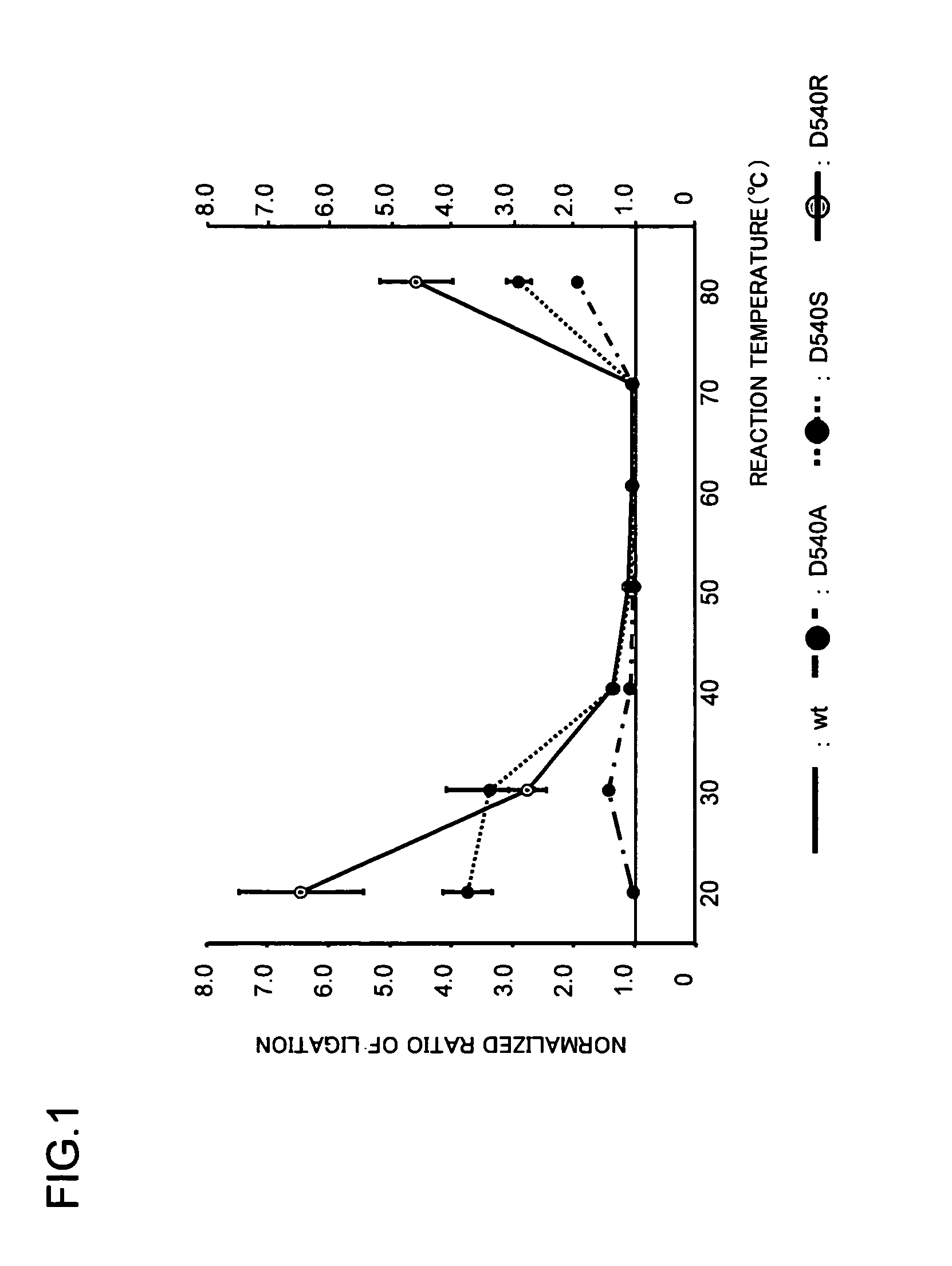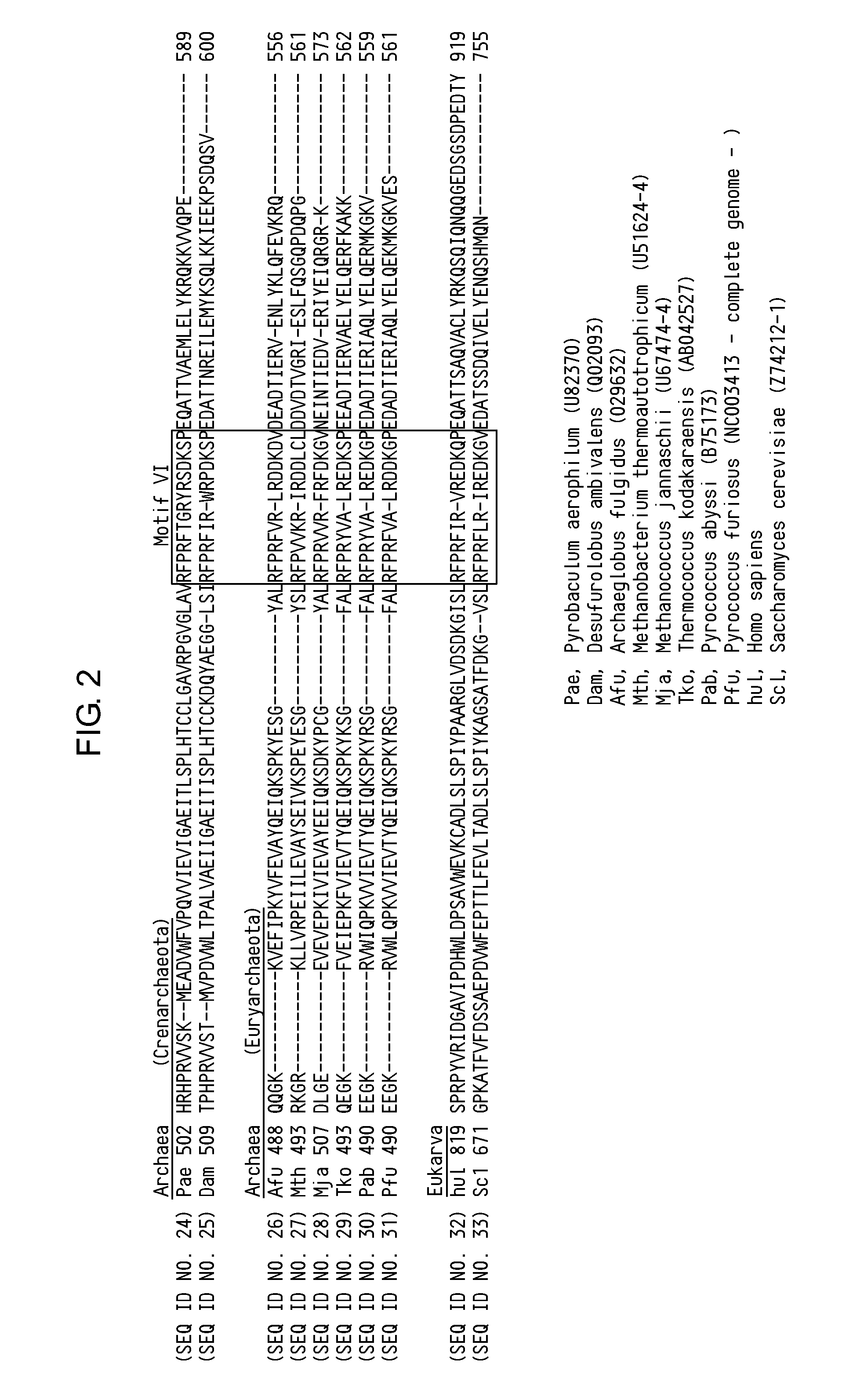Heat-resistant DNA ligase with high reactivity
a dna ligase, high-reactivity technology, applied in the field ofvariant dna ligases, can solve the problems of poor thermostability, low dna binding activity of thermostability dna ligases, unsuitable for lcr method, etc., to achieve rapid and highly specific lcr method, superior dna binding activity and reaction activity, the effect of high sensitivity
- Summary
- Abstract
- Description
- Claims
- Application Information
AI Technical Summary
Benefits of technology
Problems solved by technology
Method used
Image
Examples
example 1
Preparation of Ligase with Mutation Introduced in the C-Terminal Helix
[0047](1) Preparation of Pyrococcus furiosus Genomic DNA
[0048]P. furiosus DSM3638 was obtained from Deutsche Sammlung von Mikroorganismen and Zelkulturen GmbH, and cultured following the method described in the literature (Nucleic Acids Research, Vol. 21, 259-265). About 1.2 g of the bacteria was obtained from 500 ml of the culture medium. These bacteria were suspended in 10 ml of Buffer L (10 mM tris-hydrochloric acid (pH 8.0), 1 mM EDTA, 100 mM NaCl), and 1 ml of 10% SDS was added thereto. After stirring, 50 ml of proteinase K (20 mg / ml) was added and the suspension was left standing for 60 minutes at 55° C. The reaction mixture was then extracted sequentially, first with phenol, then phenol-chloroform, and finally with chloroform. Then ethanol was added to produce insoluble DNA. The DNA recovered was dissolved in 1 ml of TE solution (10 mM tris-hydrochloric acid (pH 8.0), and 1 mM EDTA), and 0.75 mg RNase A was...
example 2
[0059]Comparison of the Reaction Activities Between the Wild Type and the Variant DNA Ligases Having Mutation Introduced at the Aspartic Acid at Position 540
[0060](4) The 40 mer oligo DNA (SEQ ID NO: 21) which was the template, the 30 mer oligo DNA (SEQ ID NO: 22) that had been phosphorylated at the 5′-terminus, and the 20 mer oligo DNA (SEQ ID NO: 23) that had been labeled at the 5′-terminus with the fluorescent substance TET were each prepared as 0.5 mM solutions, and an oligo DNA mixture was prepared by mixing 5 μl of each solution. The sequences of the oligo DNAs used are shown in Table 2. The oligo DNA mixture thus prepared was thermally denatured at 95° C. for 5 min. From 94° C., the temperature was lowered to 2° C. at the rate 1° C. per 5 min to hybridize the 3 oligo DNAs and prepare the annealed product. The ligation reaction (13) was carried out using the resultant annealed product as the template. The reaction product was subjected to electrophoresis using 15% acrylamide / 8...
example 3
Thermostability of Variant DNA Ligases of the Present Invention
[0063]Both the wild type and the variant DNA ligases used in Example 2 were heat-treated at 85° C. for 20 minutes in the early stage of the purification to intentionally denature the non-thermostable proteins and simplify the subsequent purification procedure. In this heat-treatment, the variants showed thermostability comparable to the native ligase.
PUM
| Property | Measurement | Unit |
|---|---|---|
| temperatures | aaaaa | aaaaa |
| temperature | aaaaa | aaaaa |
| temperature | aaaaa | aaaaa |
Abstract
Description
Claims
Application Information
 Login to View More
Login to View More - R&D
- Intellectual Property
- Life Sciences
- Materials
- Tech Scout
- Unparalleled Data Quality
- Higher Quality Content
- 60% Fewer Hallucinations
Browse by: Latest US Patents, China's latest patents, Technical Efficacy Thesaurus, Application Domain, Technology Topic, Popular Technical Reports.
© 2025 PatSnap. All rights reserved.Legal|Privacy policy|Modern Slavery Act Transparency Statement|Sitemap|About US| Contact US: help@patsnap.com


